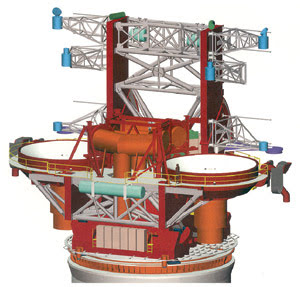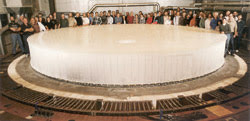Spin-cast parabolic mirrors are revolutionizing telescopes and may one day allow astronomers to view extrastellar planets orbiting distant stars.
Brent D. Johnson, Senior News Editor
Tucson, at first, seems a remote spot for the world’s foremost optical sciences laboratory.
Arising from the parched red crust of the Arizona landscape, manicured lawns and
English gardens betray an extensive field of subterranean aquifers similar to those
that planetologists hope to discover on Mars. The comparison is not inappropriate.
In the outlying regions of the city, the tracts of homes and businesses quickly
give way to an unearthly terrain of jagged rock, cracked and worn by heat and whipped
by winds into fine brick dust.
The absence of atmospheric moisture and the relative
isolation of the region from polluting light sources provide an uninterrupted supply
of deep blue skies that make for pristine viewing conditions in the mountains to
the north and east of the city. High above the desert at the Lowell Observatory
in Flagstaff, Clyde Tombaugh discovered the planet Pluto and V.M. Slipher meticulously
laid the groundwork for Edwin Hubble’s big bang theory.
Astronomers have been attracted from
around the globe to conduct research at the 10-m Heinrich Hertz Submillimeter Telescope
and the 1.8-m Vatican Advanced Technology Telescope, both atop Mount Graham, which
rises above the Sonoran Desert to an elevation of 10,413 ft. At this vantage, the
rarefied atmosphere offers little resistance to the weak pulses traveling from the
ends of the universe.
Underground lab
I recently joined Jim Trexler, docent of the Smithsonian
Institution’s Fred Lawrence Whipple Observatory on Mount Hopkins, for a guided
tour of the University of Arizona’s Steward Observatory Mirror Laboratory.
This was his first time back to the lab since it was closed to the public last year,
so we were both excited about seeing the progress that had been made on the mirrors.

Figure 1. The two 8.4-m mirrors made at the Steward Observatory Mirror Laboratory will operate jointly to provide the sensitivity of an 11.8-m mirror, at a cost less than that
of a conventional 8-m telescope.
The lab is in a vault underneath the
bleachers of the Arizona Wildcats’ football stadium. It is encased in concrete
and anchored to the bedrock. The stadium offered an existing structure from which
to mount heavy lifting apparatus to handle the mirrors. Vibration isolation for
optical testing is provided by a steel and concrete tower assembly that weighs 440
tons and that rests on an air-actuated isolation system.
Since the early 1980s, the lab has
revolutionized astronomy by creating large, lightweight mirrors using a spin-casting
technique that produces a highly efficient parabolic reflector. Such mirrors could
not have been built using traditional grinding and polishing techniques, and their
high-speed f/1.1 focal ratio enables much shorter telescopes with greater
light-collecting capability, thus reducing the cost of erecting new observatories.
Spin-cast parabolic mirrors
The first mirror made by the spin technique, built
for the Vatican Observatory, was 1.8 m in diameter. Since then, three 3.5-, three
6.5- and two 8.4-m spin-cast primaries have been produced. Except for the 8.4-m
mirrors, all are in operation. A fourth 6.5-m casting is in progress, and a third
8.4-m casting will follow.
The first 6.5-m mirror is operating
at Multiple Mirror Telescope Observatory on Mount Hopkins, a joint facility of the
university and the Smithsonian. The mirror’s success has been such that the
Carnegie Institute, which is a competitor of the Smithsonian for federal funds,
has ordered two of the 6.5-m mirrors for use in its Magellan Observatory in Las
Campanas, Chile. The 6.5-m primary mirrors were all figured to an accuracy of between
15 and 20 nm rms.
The 1.8-m mirror that Steward lab made
for the Vatican Observatory, which Trexler said is quite opulent by most astronomers’
standards, is accurate to within λ/50. The laboratory’s pièces de résistance,
however, will be the twin 8.4-m mirrors constructed for the Large Binocular Telescope.

Figure 2. The casting oven spins as it reaches 1160 °C and molten
glass fills the honeycomb infrastructure of the Large Binocular Telescope’s
first mirror.
The binocular telescope, which is now
under construction at Steward, will be the fruition of 20 years of development in
materials and spin-casting technology. The two large mirrors will work in tandem
and permit astronomers to view the early formation of galaxies. The telescope brings
together light from two 8.4-m telescopes, creating the world’s largest interferometer.
The light from one telescope will cancel the light from the other to within λ/2,
allowing astronomers to remove stars from the field of view and leaving only the
faint spectra from extrastellar planets. When the mirrors from the telescope are
combined with adaptive optics, the binocular system will be a true diffraction-limited
telescope with a resolution 10 times that of the Hubble Space Telescope.
The adaptive optics that were planned
for the Large Binocular Telescope were developed by the US Air Force to facilitate
high-energy laser beam propagation through the atmosphere for weapons to destroy
satellites. Later, the technology was applied to astronomical and other imagery
applications, including laser eye surgery.
The first application of Steward-engineered
adaptive optics will be on the f/15 secondary mirror that was fabricated
for the Multiple Mirror Telescope. This consists of a 64-cm-diameter Zerodur (glass-ceramic)
shell and a 1.8-mm-thick convex hyperbola. Behind it, 336 actuators control the
figure of the secondary mirror itself, replacing the usual adaptive element that
is added downstream from the telescope. This reduces the thermal noise in IR imaging.
Artificial star
On the Large Binocular Telescope, the secondaries
will be concave ellipses 2 mm thick and 911 mm in diameter, and there will be almost
700 actuators.
The way the adaptive optics system
works is that a laser is fired up the axis of the telescope to the ionosphere,
producing an artificial star. The system measures the distortion produced by atmospheric
effects, and directive optics change the shape of the mirror 500 to 1000 times per
second to compensate for the interference.
Because it would be impractical to
try to move an 8.4-m mirror, the binocular telescope uses a smaller secondary mirror
with 672 solenoids that act like high-fidelity speakers to push and pull the mirror
surface by angstroms. Early on, the designers used quartz crystals in these mirrors,
but the piezoelectric effect produced by the compression of the quartz generated
unwanted heat. Now they use glass.
For spectroscopy, you don’t need
adaptive optics, Trexler said. But if you’re trying to view planets in distant
galaxies, they’re necessary.
Constructing the telescope
The laboratory uses a unique honeycomb lattice
for its mirrors that requires far less mass than previous designs and that cools
more rapidly so that there is no variation between the mirror temperature and the
nighttime air. The latticed mirrors weigh only one-fifth of what they would if they
were solid. The integrity of the honeycomb design makes the mirrors big, stiff and
light. “Bees taught us this,” Trexler said.
Once the 1662 hexagonal cores are assembled
on a giant turntable, chunks of borosilicate glass are placed onto the ceramic superstructure.
A large furnace is lifted into place over the mirror, and computer-controlled heating
elements are fired to 1160 °C until the glass becomes the consistency of honey
and sinks into the honeycomb. All the while, the enormous mirror and furnace are
spinning at 7 rpm to produce the parabolic shape.
CCD cameras inside the furnace monitor
surface uniformity by regulating temperature and the configuration of the mirror.
As the glass liquefies and flows into the structure, metal tension bands surrounding
the mirror crimp inward to regulate the expansion of the heated material and to
prevent the walls of the mold from collapsing under the hydrostatic pressure. Gradually,
after several hours, the parabola emerges.
After about three months of cooling,
the mirror is integrated into a polishing cell, which supports it on 160 actuators
that preserve its shape, compensating for adjustments in temperature and gravity.
The mirror surface is polished to critical accuracy by a floating raft-stressed
lap that continually assumes the shape of the parabola as it is moved over the surface.
This process may take as long as a year to complete. The first of the mirrors being
prepared for the binocular telescope has already been cast and is being polished
to an accuracy of 20 nm.
When both mirrors have been finished,
36 suction cups and two vacuum pumps will lift them into padded boxes for transportation
to Mount Graham. After they have been mounted in the telescope, the final aluminum
coating will be applied to the surface.
One drawback of the mirrors is that
protective coatings might interfere with collecting power; thus, the mirrors are
nothing more than exposed raw metal. The metal layer is electrically deposited by
exploding evaporating filaments of aluminum over the mirror under a vacuum, which
results in a mirror surface that has approximately 85 percent efficiency. The deposition
process takes place under a steel bell jar in most cases and occurs in situ. This
aluminum coating must be chemically stripped from the mirror and reapplied approximately
every two years. In part because of the coating problem, Trexler believes that,
in the future, more and more mirrors will be constructed in place and that glass
factories will be built on location to better serve the observatories.
The goal
When the Large Binocular Telescope is pointed
toward the heavens for the first time, probably in 2003, it will view a universe
that is 10 times closer than previous instruments could resolve. Some of the objects
that astronomers are most hoping to see will be extrastellar planets orbiting distant
stars. These planets, perhaps similar to our own, may teach us about the evolution
of our solar system and the unique place that our world holds in the cosmic scheme.